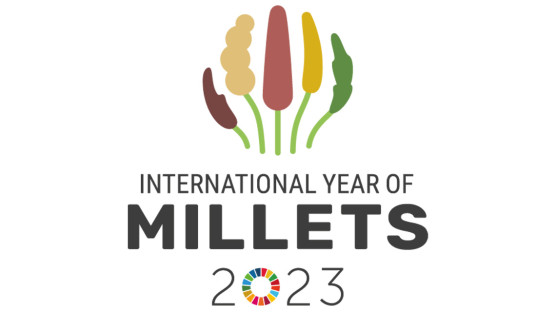The IAEA, through the Joint FAO/IAEA Centre of Nuclear Techniques in Food and Agriculture, is launching a new Coordinated Research Project (CRP) focused on Accelerated Genetic Improvement of Key Dryland Millets for Climate Change Adaptation, spanning a five-year timeframe from 2024 to 2028.
Millets, hardy dryland crops that can grow with minimal inputs in Asian and African countries, are gaining popularity due to their nutritional qualities and resilience to climate change. They present an ideal solution for countries to increase self-sufficiency and reduce reliance on imported cereal grains. Millets are rich in dietary fibres, proteins, minerals (iron, potassium, magnesium, and phosphorous) and vitamins. Additionally, millets exhibit exceptional efficiency in water and nitrogen use, enabling them to flourish in water-deficit conditions in rain-fed regions. They require minimal irrigation and nitrogen fertilizers to achieve better yields. Thanks to their nutritional superiority and climate resilience features, small millets can supplement staple cereal crops. They are rich in micro- and macro-nutrients, proteins, essential amino acids, dietary fibre, and resistant starch.
This CRP will focus on improving the grain yield of pearl millet (Pennisetum glaucum), finger millet (Eleusine coracana (L.) Gaertn.) and proso millet (Panicum miliaceum L.) to several biotic and abiotic stresses in the face of climate change. Increasing the yield of these millets for climate change adaptation could have a major positive impact on food security, improved health and income generation for millions of impoverished and vulnerable people.
Pearl millet (Pennisetum glaucum) is the major millet, accounting for approximately 50 per cent of total millet production. However, blast, also known as leaf spot disease, a seed and wind-borne disease caused by Pyricularia grisea Sacc., has emerged as a severe threat in recent years across major pearl-millet-growing regions. Another significant disease affecting pearl millet is downy mildew caused by Sclerospora graminicola. This is a systemic and devastating disease that can completely destroy infected plants and lead to up to 100 per cent grain loss in highly susceptible cultivars. Achieving stable and durable resistance to these diseases is challenging due to temporal changes in the virulence of the pathogen, which can lead to a rapid breakdown of resistance.
Finger millet (Eleusine coracana (L.) Gaertn.) blast disease is caused by the fungus magnaporthe oryzea which is a global pathogen occurring in all areas where the crop is grown. Finger millet blast affects all growth stages of its host, from the seedling stage through grain formation and can cause over 90 per cent yield losses. Drought can occur at any stage of finger millet development; however, the most damaging droughts for finger millet are those that occur at the seedling stage just after germination and at the flowering stage.
Proso millet (Panicum miliaceum L.) is cultivated in many countries because of its short growing cycle (60-90 days), minimal input requirements and resilience to biotic and abiotic stresses. However, it does have certain challenges, including small seeds, seed shattering and a shallow root system which makes it susceptible to lodging. The most important selling point of the crop is its high protein content. Therefore, development of gene specific markers is critical to facilitate rapid screening of proso millet lines for high protein content. Additionally, conducting transcriptomics, proteomics and metabolomics studies will enhance our understanding of protein accumulation in proso millet in relation to yield. Mutation in proso millet can lead to the development of new varieties that do not exist in the germplasm, with characteristics such as non-shattering, deep root system, uniform maturity of panicles and bold grains.
Objective of the CRP
To develop novel genetic stocks of key dryland millets using mutation breeding and biotechnologies to accelerate the development of new varieties for food and nutrition security and climate-change adaptation.
Specific objectives
- To generate genetic diversity in selected millets with improved nutrition and quality traits, and improved resilience to biotic/abiotic stress through induced mutation for better adaptation to climate change,
- To develop/adapt phenotyping tools for precise screening/selection of mutant lines with the desired traits in selected millet crops,
- To develop genomic tools for delivery of novel induced variation to accelerate genetic gain in millet improvement.
Expected Research Outputs
- Generation of novel millet germplasm as sources of climate change adaptation,
- Mutant lines improved and identified for traits of interest,
- Efficiency enhancing techniques to speed up the process of identification, development, and deployment to adapt to climate change,
- Molecular markers, genomic selection and gene editing technologies,
- Scientific publications from the findings of the research activities.
How to join this CRP
Up to ten research contracts are expected to be awarded and five no-cost agreement holders from advanced laboratories and research institutes with recognized expertise in the targeted technologies will be invited to share their experience with the contract holders and contribute to the development and validation of the planned technical packages. Additionally, two technical contracts are foreseen to be awarded for services in advanced areas, such as functional genomics, the establishment of genetic association for traits of interest, genomic selection, and gene editing technologies. Coordination and technical management will be handled by the scientific secretary in the Plant Breeding and Genetics Section with the involvement of the Plant Breeding and Genetics Laboratory.
Please submit your Proposal for Research Contract or Agreement by email, no later than 15 December 2023, to the IAEA’s Research Contracts Administration Section, using the appropriate template on the CRA web portal. Same form can be used for the research contract and the technical contract.
For further information related to this CRP, potential applicants should use the contact form under the CRP page.





